Chapter II.
How We Found Mojave
WHEN the automobile was delivered into our hands at Los Angeles we wanted to turn around immediately and drive back through the Cajon Pass into the Mojave Desert, but our inquiries about directions met with discouragement on every side. It seemed to be unheard of for two women to attempt such a thing; the distances between the towns where we could get accommodations were too great and the roads were apt to have long stretches of sand where we would get stuck. Our friends drew a dismal picture of us sitting out in the sagebrush beside a disabled car and slowly starving to death."You could not fix it," they said, "and what would you do?"
We suggested that we might wait until somebody came along.
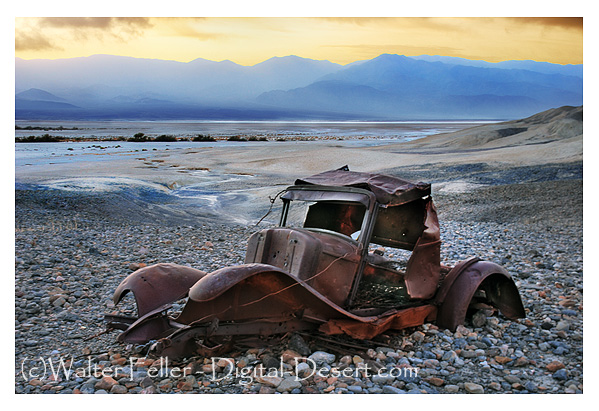
They assured us that nobody ever came along.
We went to the Automobile Club; they received us with enthusiasm and told us about all the places California is proud of and how to get to them, but California seems not to be proud of the desert, for when we mentioned it our advisers became gloomy. They seemed to have no very definite information and were sure we would not like it. In the face of so much discouragement we hardly dared to ask about Death Valley and when we did, hesitatingly, the question was ignored. We simply could not get there, nobody ever went. The Imperial Valley seemed to be almost as bad. One of the maps they gave us showed a main highway from San Diego over into it, but they said that it was only a gravel road, mountainous and steep, and that we had better stick to the main routes. Evidently they had no faith in our skill as drivers, nor belief in our purpose, so we soon gathered up the maps and innumerable folders about resort hotels, thanked them, and went our way.
The collection contained no map of the Mojave. She had called us, but not loudly enough as yet, and now that we no longer saw her we remembered her terribleness more than her fascination. We would content ourselves with the Imperial Valley, at least for a beginning; but we said nothing more about it and started down the coast with every appearance of having a ladylike programme. In our then mood we hated the coast and were guilty of speeding along the fine macadam between Los Angeles and San Diego in our eagerness to leave it. We turned due east from the green little city on the shores of its beautiful harbor and headed for the desert. Our unsatisfactory interview at the Automobile Club had led us to believe that the Imperial Valley, irrigated or not, was a wild and lonely place, the desert itself, for it seemed to be surrounded by difficulties.
The road from San Diego proved to be good, presenting no hindrances not easily surmounted, and as we drove along it we told each other what we thought about the Automobile Club. Gradually the character of the country changed. A little of the prickly, spiky desert vegetation with which we were to become so familiar appeared. The round hills gave way to piles of bare, colored rock, the soil became a gravelly sand on which scrub oak and manzanita grew. The houses became fewer. In one place we had to detour and found deep, soft sand, nothing to the sand of a real desert road, but we did not know that then. The change was subtle, yet we felt it. The country took on the harshness that had repelled us from the train-windows. Being alone in it was at first a little dreadful.
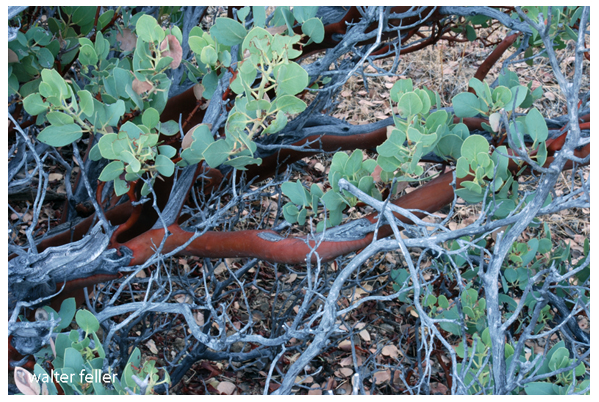 Manzanita
ManzanitaAfter a day or so of leisurely driving we came suddenly to the edge of the valley. The ground fell before us, cut into rough canyons and foothills, two thousand feet to a blue depth. It was like a great hole full of blue mist, surrounded by red and chocolate-colored mountains. Nothing was clear down there though the mountains were sharply defined and had indigo shadows on them. The valley was a pure, light blue, of the quality of the sky, as though the sky reached down into it. We lingered a long time eating our lunch on a jagged rock, trying to pierce the blue veils and see the Salton Sea, a big salt lake which we knew was there with the tracks of the Southern Pacific beside it, the sand dunes we had heard of, and the town of El Centro where we were to spend the night. We could see nothing of them, only a phantasy of changing color, an unreality.
We found the whole desert full of drama, but the Imperial Valley is perhaps the most dramatic spot of all, except Death Valley, that other deep hole below sea-level which is so much more remote and so utterly lonely. The great basin of the Imperial Valley was once a part of the ocean until the gradual silting up of its narrow opening separated it from the Gulf of California. The bottom of the valley then became an inland sea which slowly evaporated under the hot sun, leaving as it receded a thick deposit of salt on the sand. At last the valley was dry, a deep glistening bowl between chocolate- colored mountains, a white desolation undisturbed by man or beast, covered with silence. For ages it lay thus while morning and evening painted the hills.
Then the railroad came with its thread of life, connecting Yuma with San Bernadino and Los Angeles. Soon a salt-works was built in what had once been the bottom of the ocean, and later an irrigation-system for the southern end of the valley from the Colorado River which flows just east of the Chocolate Mountains. The white desolation was made to bloom and, in spite of the intense heat of summer, has become one of the richest farming districts of California. But the drama is still going on. A few years ago the untamed Colorado River that had fought its way through the Grand Canyon and come two hundred miles across the desert turned wild and flooded into the Imperial Valley. It was shut out again, but it left the new Salton Sea in the old ocean bed. Its yellow waves now break near the irrigated area; it drowned the salt works. The Salton Sea is slowly vanishing as its predecessor did; in a little while the valley will again be dry and white and glistening.
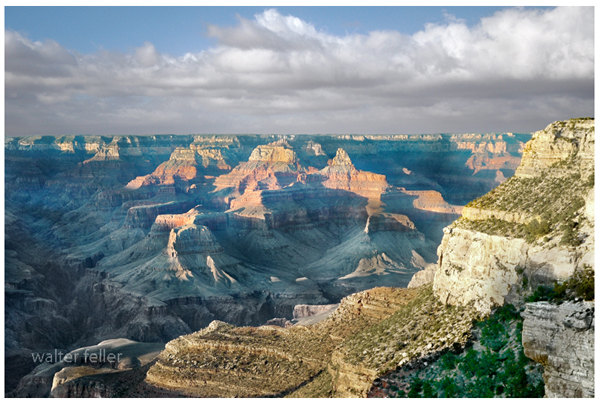
Grand Canyon
The road descended before us in jigjags to the blue depth. It was a good road but narrow in places, dropping sheer at the edge, and steep. Very carefully we drove down, emerging at last through a narrow, rough canyon onto the sandy floor of the valley. A macadam road led like a shining band through the sagebrush. This evidence of civilization was strange in the surrounding wilderness, for as yet we could see no sign of life in the valley. The sand came up to the edge of the road and was blown into dunes between us and the new sea. There was nothing but sunshine and sagebrush and flowers. The flowers amazed us, for why should they grow there? There was a yellow kind that outshone our perennial garden coreopsis, and numberless little flowers pressed close to the sand with spread-out velvet, or shining, or crinkled blue or frosted leaves. We had to get out of the car to see them, and whenever we got out we felt the heat blaze around us. We were below sea level and even in February it was very hot. The light was almost blinding, and a silver heat shimmer swam between us and the mountain walls. The mountains seemed to be of many colors which changed as the afternoon advanced. The sun set in a more vivid purple and gold than we had ever seen.
We lingered so long looking at the strange plants and flower that twilight found us still alone with the desert. Only the white macadam band promised any end to it. Realizing that night was coming and we had an unknown number of miles before us we stepped on the accelerator with more energy than wisdom. The result was a loud explosion of one of the brand new rear tires. We found the tire so hot that we had to wait for it to cool before we could change it, and the road hot to touch though the sun had been down for some time. We called ourselves all manner of names for being such fools as to try to drive fast on that sizzling surface. It was the first practical lesson about getting along on the desert.
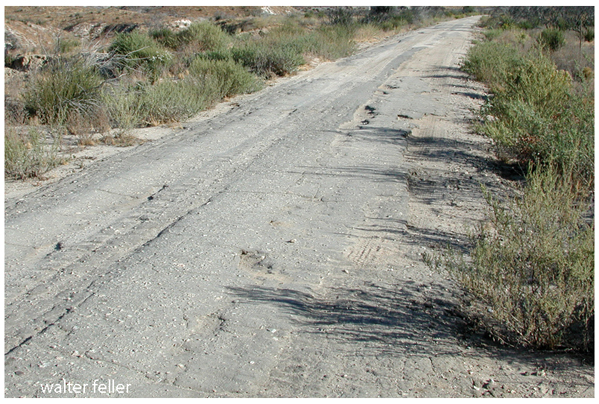
A good road led through the Cajon Pass to Victorville
Soon after that we came to an irrigation-ditch. Instantly everything was changed and we were in a farming country. El Centro is a hustling town with a modern four-story hotel. We wished it were not four stories when we learned that part of it had recently been shaken down by an earthquake, and especially when we experienced three small shocks during that night. The earthquakes themselves did not seem surprising, they were a fitting part of the weird experiences of the day. We felt as though we had been very near to the elemental forces of nature; we had been with the bare earth and volcanic rocks and strange plants that flourish in dryness, and felt the unmitigated beat of the sun. It was like seeing the great drama of nature unveiled, fierce and beautiful.
We stayed several days in the Imperial Valley, visiting the Salton Sea, figuring out the beach lines of that other more ancient sea, and walking among the sand dunes. We found that we always went away from the farms into the desert. She was calling us loudly enough now. We heard her and were determined to find more of her. When we tried to go on, however, we met with the same universal discouragement. In El Centro they said that the road out through Yuma to the desert east of the Chocolate Mountains was very bad, and the road up the Valley through Palm Springs and Banning no road at all. Besides, there was no water anywhere. Later we found out that none of these things were exactly true, but it probably seemed the best advice to give two lone women with no experience of desert roads. Our appearance must have been against us. Certainly it was no lack of persistence, for we interviewed everybody, hotel-managers, ranchers, druggists and garage-men. They all looked us over and gave the same advice. As far as we could learn, the Mojave Desert which we tried to go to in the first place was where we should be. We suspect now that they wanted to get rid of us.
We returned to Los Angeles and attacked the Automobile Club again. As before we had to listen to arguments about the roads and the sand and the distances and the accommodations, but this time we listened unmoved. With a defiant feeling very reminiscent of youth we purchased a shovel and two big canteens to fasten on the running-board because we had observed that all the cars in the Imperial Valley were thus equipped. These implements gave us a feeling of preparedness. We also bought some blankets and food lest we should break down on a lonely road. We knew what we wanted now and the Automobile Club found a map. It was an inspiring map covered with a network of black roads and many towns in bold type. We studied it and found that we could never get more than thirty miles from somewhere, and we thought we could walk that if we had to. For some reason no one told us to beware of abandoned towns and abandoned roads, perhaps they did not know about them. One of the black lines led straight toward Death Valley. Once more we said nothing about our destination, and started.
A good road led through the Cajon Pass to Victorville and thence over sand dotted with groves of Joshua palms to Barstow. A Joshua palm is a grotesque tree-yucca which appears wherever the mesas of the Mojave rise to an elevation of a few thousand feet. It becomes twenty feet high in some places and its ungainly arms stick up into the sky. It has long, dark green, pointed leaves ending in sharp thorns like the yucca. It attains to great age and the dead branches, split off from the trunk or lying on the ground, look as though they were covered with matted gray hair. Charlotte and I never liked them much, they seemed like monsters masquerading as trees; but in that first encounter, when we drove through them mile after mile in a desolation broken only by the narrow ribbon of the gravel road, they were distinctly unpleasant and we were glad when we left them behind at Barstow.
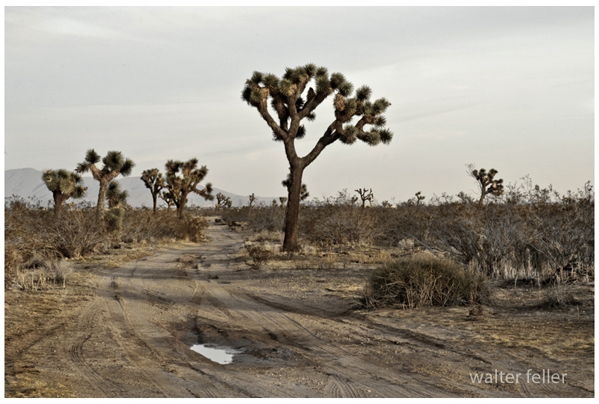
A Joshua palm is a grotesque tree-yucca
There seemed to be a choice of routes from that town so we had an ice cream soda and interviewed the druggist, having discovered that druggists are among the most helpful of citizens. He proved to be an enthusiast about the desert, the first we had met, and we warmed to him. He brought out an album full of Kodak-pictures of the Devil's Playground where the sand-dunes roll along before the wind. He grew almost poetic about them, but when we spread out the map and showed him the proposed route to Death Valley he grew grave. He said the road was so seldom traveled that in places it was obliterated. We would surely get lost. Silver Lake, the next town on it, was eighty-seven miles away. There was one ranch on the road but he was not sure any one was living there. He was not even sure we could get accommodations at Silver Lake. Yes, it was a wonderful country; you went over five mountain ridges. He forgot himself and began to describe it glowingly when a tall man who was looking at the magazines interposed with: "Surely, you would not send the ladies that way!"
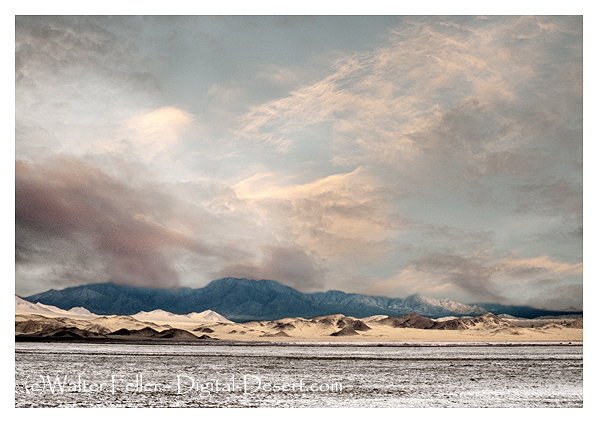
Devil's Playground
The two words "get lost" were what deterred us. We felt we could cope with most calamities, but already, coming through the Joshua palms, we had sensed the size and emptiness of Mojave. At least until we were a little better acquainted with the strange land where even the plants seemed weird, we needed the reassurance of a very definite ribbon of road ahead. We decided to go to Randsburg, then to Ballarat and try to get into Death Valley from there. The druggist doubted if we could get into the valley at all. We began to suspect that it might be difficult.
Randsburg, Atolia and Johannesburg are mining towns close together about forty miles north of Barstow. The road there was no such highway as we had been traveling upon; often it was only two ruts among the sagebrush, but it was well enough marked to follow easily. Great sloping mesas spread for miles on either side of the track, rising to rocky crowns. All the big, open, gradually ascending sweeps are called mesas on the Mojave, though they are in no sense table-lands like the true mesas of New Mexico and Arizona. The groves of Joshua palms had disappeared; we were lower down now where only greasewood and sagebrush grew. The unscientific like us, who accept the word "mesa," lump together all the varieties of low prickly brush as sagebrush. The little bushes grew several feet apart on the white, gravelly ground, each little bush by itself. They smoothed out in the distance like a carpet woven of all shades of blue and green. The occasional greasewood, a graceful shrub covered with small dark green leaves, waved in the wind. Unobstructed by trees the mesa seemed endless. We stopped the car to feel the silence that enveloped it. The place was vast and empty as the stretches we had seen from the railroad, and now we found how still they all had been. The strong, fresh wind pressed steadily against us like a wind at sea.
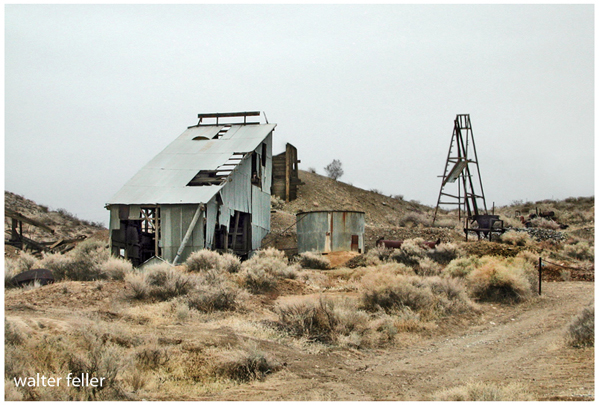
Randsburg, Ca.
Atolia was the first town, golden in the setting sun, on the shoulder of a stern, red mountain. Before it a wide valley fell away in whose bottom gleamed the white floor of a dry lake. All the mountain tops were on fire. The three towns were very close together, separated by the shoulder of the red mountain. Randsburg was the largest, whose one street was a steep hill. It had a score of buildings and two or three stores. Johannesburg, just over the crest, had six buildings, among them an adobe hotel and a large garage. All three towns ornamented the map with big black letters. We thought we were approaching cities and found instead little wooden houses set on the sand with the great simplicity of the desert at their doors.

A stern, red mountain
According to that map Death Valley was now not more than sixty miles away. We thoroughly startled the inhabitants of Johannesburg, familiarly known as Joburg, by the announcement that we were going there. We did not yet know how startling an announcement it was; but these real dwellers on the desert, intimately acquainted with her difficulties, met our ignorance in a more helpful spirit than any of our other advisers had, even the agreeable druggist. Hardly any one ever goes to places like Joburg just for the pleasure of going, and they seemed pleased that we had come. They described the Panamint Mountains which shut off the valley from that side with a barrier nearly 12,000 feet high. There are only two passes, the Wingate Pass through which the borax used to be hauled and which is now blocked with fallen rocks, and a pass up by Ballarat. They had not heard of any cars going in for some time. Unhappily Ballarat had been abandoned for several years and we could not stay there unless we could find the Indians, and no one knew where they were. None of the Joburgians whom we first interviewed had ever been to Death Valley.
It was discouraging, but we persevered until we found a real old-timer. He was known as Shady Myrick. We never discovered his Christian name though he was a famous desert character. Wherever we went afterward everyone knew Shady. Evidently the name was not descriptive for all agreed on his honesty and goodness. He was an old man, rather deaf, with clear, very straightforward-gazing eyes. Most of his life had been spent on the Mojave as a prospector and miner, and much of it in Death Valley itself. The desert held him for her own as she does all old-timers. He was under the "terrible fascination." As soon as we explained that we had come for no other purpose than to visit his beloved land he was eagerly interested and described the wonders of Death Valley, its beautiful high mountains, its shining white floor, its hot brightness, its stillness, and the flowers that sometimes deck it in the spring.
"If you go there," he said, "you will see something that you'll never see anywhere else in the world."
He had gem mines in the Panamints and was in the habit of going off with his mule-team for months at a time. He even said that he would take us to the valley himself were he a younger man. We assured him that we would go with him gladly. We urged him—you had only to look into his eyes to trust him—promising to do all the work if he would furnish the wagon and be the guide, innocently unaware of the absurdity of such a proposal in the burning heat of Death Valley; but he only smiled gently, and said that he was too old.
Silver Lake turned out to be the place for us to go after all. He described how we could drive straight on from Joburg, a hundred and sixteen miles. There was a sort of a road all the way. He drew a map on the sand and said that we could not possibly miss it for a truck had come over six weeks before and we could follow its tracks.
"It ain't blowed much, or rained since," he remarked.
"But suppose we should get lost, what would we do?"
"Why should you get lost? Anyway, you could turn around and come back."
We looked at each other doubtfully. In the far-spreading silence around Joburg the idea of getting lost was more dreadful than it had been at Barstow. There was not even a ranch in the whole hundred and sixteen miles. We hesitated.
"You are well and strong, ain't you?" he asked. "You can take care of yourselves as well as anybody. Why can't you go?"
"You have lived in this country so long, Mr. Myrick," I tried to explain, "you do not understand how strange it is to a newcomer. How would we recognize those mountains you speak of when we do not even know how the desert mountains look? How could we find the spring where you say we might camp when we have never seen one like it?"
"You can do it," he insisted, "that's how you learn."
"And there is the silence, Mr. Myrick," I went on, hating to have him scorn us for cowards, "and the big emptiness."
He understood that and his face grew kind.
"You get used to it," he said gently.
It was refreshing to meet a man who looked into your feminine eyes and said: "You can do it." It made us feel that we had to do it. We spent a whole day on a hilltop near Joburg looking longingly over the sinister, beautiful mountains and trying to get up our courage. Happily we were spared the decision. Two young miners at Atolia sent word that they were going over to Silver Lake in a few days and would be glad to have us follow them. Perhaps it was Shady's doing. We accepted the invitation with gratitude.
We loafed around Joburg during the intervening days. The stern, red mountains were full of mine-holes, but most of the mines were not being worked and the three towns were dead. Everywhere on the Mojave Desert mining activity had fallen off markedly after the beginning of the war. The population of the three towns had dwindled away and the few people who remained did so because they still had faith in the red mountain and hoped that the place might boom again. The big hotel at Joburg, which was attractively built around a court and which could accommodate twenty to thirty guests, was empty save for us. We looked at and admired innumerable specimens of ore. They were everywhere, in the hotel-office, in the general store, in the windows of the houses. Everyone had some shining bit of the earth which he treasured. We bought some of Shady Myrick's cut stones and received presents of gold ore and fine pieces of bloodstone and jasper in the rough.
We enlisted the services of the garage to get our car in the best possible condition for the journey across the uncharted desert. The general opinion held that it was too heavy for such traveling; the next time we should bring a Ford. When the two young men appeared early on the appointed morning with a light Ford truck dismantled of everything except the essential machinery they also looked over our big, red car questioningly. They feared we would get stuck in the sand and jammed on rocks; but generously admitted themselves in the wrong when, later in the day, they stuck and we did not. Of course they had the advantage, for we would probably have remained where we stopped, while the four of us were able to lift and push the little truck out of its troubles. It was the most disreputable-looking car we had ever encountered even among Fords, a moving junkpile loaded with miscellaneous shabby baggage, tools, and half-worn-out extra tires. Our new friends matched it in appearance. They looked as tough as the Wild West story-tellers would have us believe that most miners are. We have found out that most miners are not, though we hate to shatter that dear myth of the movies. If you were to meet on any civilized road the outfit which we followed that day from seven o'clock in the morning until dark you would instantly take to the ditch and give it the right of way.
The drive was wild and fearful and wonderful. The bandits led us over and around mountains, down washes and across the beds of dry lakes. Often there was no sign of a road, at least no sign that was apparent to us. On the desert you must travel one of two ways, either along the water-courses or across them. It is strange to find a country dying of thirst cut into a rough chaos by water-channels. Rain on the Mojave is a cloud-burst. The water rushes down from the rocky heights across the long, sloping mesas, digging innumerable trenches, until it reaches a main stream-bed leading to the lowest point in the valley. When you go in the same direction as the water you usually follow up or down the dry stream-beds, or washes, but when you cross the watershed you must crawl as best you can over the parallel trenches which are sometimes small and close together like chuckholes in a bad country road, and sometimes wide and deep. One of the uses of a shovel, which we found out on that day, is to cut down the banks of washes that are too high and steep for a car to cross.
Most of the mountains of the Mojave are separate masses rather than continuous ranges. Between them the mesas curve, sometimes falling into deep valleys. Instead of foothills, long gradual slopes always lead up to the rock battlements, the result of the wearing down of countless ages, the wide foundations that give the ancient mountains an appearance of great repose. They are solid and everlasting. The valleys are like great bowls curving up gently to sudden, perpendicular sides. The mesas always look smooth, beautiful sweeps that completely satisfy the eye. It rests itself upon them.
When the valleys are deep they usually contain a dry lake, baked mud of a white, yellow, or brownish-purple color. Crossing dry lakes is a curious experience. They never look very wide, but are often several miles across. You need a whole new adjustment of ideas of distance on the desert for the air is so clear that distant objects look stark and near. What you judge to be half a mile usually turns out to be five, and four miles is certainly eighteen. We were always deceived about distances until we trained ourselves a little by picking out some point ahead, guessing how far it was, and measuring it with the cyclometer. Dry lakes are not only deceitful about their size, but also about their nature. Along the edges is a strange glistening effect as though water were standing under the shore. Often the rocks and bushes are reflected in it upside down, and if the lake is large enough the illusion of water is perfect. You drive across with a queer effect of standing still, for there h not so much as a stone to mark your progress. It is like being in a boat on an actual lake. The sunlight is very dazzling on the white and yellow expanses and the heat-shimmer makes the ground seem to heave. Sometimes you have the illusion of going steeply up-hill.
Nothing grows in the lake-beds, but the mesas are covered with the usual desert-growths, sagebrush, greasewood and many varieties of cacti. A view from one of the ridges is a look into a magical country. Only enchantment could produce the pale, lovely colors that lie along the mountains and the endless variety of blues and pinks and sage-greens which flow over the wide, sagebrush-covered mesas. The dry lake far down in the bottom of the valley shines. The illusion of water at its further edges is a glistening brightness. It is hard to tell where the baked mud ends and the sand begins. It is hard to tell what are the real colors and shapes of things. If you can linger a while they change. The valley never loses its immense repose, but it changes its colors as though they were garments, and it changes the relations of things to each other. That violet crag looks very big and important while you are toiling up the mesa, but just as you are crossing the ridge and look back for the last time you see that the wine-red hill beside it is really much larger.
For a short distance we followed the old trail over which the borax used to be hauled from Death Valley. The familiar name, "Twenty-Mule-Team Borax," was touched with romance. Out of the bottom of that baffling, inaccessible valley, through a pass by the high Panamint Mountains where it is sixty miles between the water-holes, and over this weird country unlike any country we had dreamed existed in the world, this prosaic commodity was hauled by strings of laboring mules. They tugged through the sand day after day and their drivers made camp-fires under the stars. We can never see that name now on a package of kitchen-borax, humbly standing on the shelf, without going again in imagination over those two old, lonely ruts.
We lunched at a spring under a cottonwood tree—Two Springs is its name, the only water on the route. Some one once tried to graze cattle there, and the water came through a wooden trough into a cement basin. During lunch the bandits entertained us with tales of the desert. It has its own ethics. You are justified in killing a man who robs your camp or steals your burros. Out there at Two Springs we realized that it was right. If you lose your food or your pack-animal you may well lose your life. Many a prospector has never returned. The elder of the bandits remarked thoughtfully that he was glad he had never had to kill a man. He knew a fellow who had and who was hounded to death by the memory. He was justified by desert ethics, but he had no peace in his sleep.
Toward sunset we went down an endless slope among mountains, some of which were red, some yellow, some a sulphurous green, and some black. A black mountain is a sinister object. There is a kind of fear which does not concern itself with real things that might happen, but is a primitive fear of nature herself. Even the bandits admitted feeling it sometimes. It is a fear of something impending in the bare spaces, as though the mountains threatened. A little creeping chill that had nothing to do with the cool of evening kept us close behind the Ford. At the bottom of the rough slope lay a somber basin full of shadow, beyond which rose an abrupt, high ridge of sand. In spite of us the Ford gained there and we saw it far ahead crawling up the ridge like a black bug. It seemed to stop and jerk and stop and jerk again. Then it disappeared over the top. For a few fearful moments we were alone with Mojave. How could rocks and sand and silence make us afraid and yet be so wonderful? For they were wonderful. The ridge was orange against a luminous-orange sky, the sand in the shadowy basin reached right and left, mysteriously shining, to mountains with rosy tops. The darkness around us was indigo, the two crooked ruts of the Ford were full of blue. Apprehensively, jerking and stopping, stopping and jerking, as the Ford had done, the engine clanking as though it would smash itself to pieces, the radiator boiling frantically, we bucked our way to the summit of the ridge. It looked down on an immense dry lake in a valley so big that the mountains beyond were dim in the twilight. At the far side of the lake stood a group of eight or ten portable houses, bright orange beside the purple darkness of the baked mud lake. It was the town which we had made that incredible journey to reach. Below us we could see the little truck struggling through the sand. Presently it reached the hard edge of the lake and merged with its dark smoothness. We followed down the ridge in its ruts and drove for three miles straight across the hard lake-bed toward the town, where now a few lights gleamed. The orange faded from the houses and the whole valley became a rich plum-color. It was dark when we came out onto the sand again and drove into the lonely haflilet.
A kindly German couple received us. They were as amazed to see two women arrive in a big car as we were at arriving. Once two men had come in a Cadillac just to see the desert, but they could remember no other visitors with such an unusual object. Mrs. Brauer doubted if we would find much to look at in Silver Lake. We assured her that we found much already and hoped to find much more.
"And where did you think you vas going?" her husband asked, chuckling vastly in the background.
"To Death Valley."
"Mein Gott!"
They conducted us to a one-room shack beside the tin can dump and bade us be at home. Strangely enough we felt at home. The door of the shack faced the open desert, the threshold only three inches above the sand. It stretched away white and still, radiating pale light. The craving which had made us seek a wild and lonely place responded to it. The night was a deep-blue, warm and luminous. A hard young moon, sharp as a curved knife blade, hung over the hills. We went out into the vague brightness among the ghostly bushes, and at last onto the darkness of the lake-bed. Beyond it the sand gleamed on the ridge we had come over. On either side the mountains we had feared were strong, beautiful silhouettes. In the northwest stood the mass of the Avawatz, a pure and noble skyline glowing with pale rose. The Avawatz had been the most fearful mountain of all in the sultry afternoon, a red conglomeration of volcanic hills. We walked on and on, full of a strange, terrible happiness. The trackless, unbroken expanse of the lake seemed boundless, the mountains were never any nearer. We kept looking back for the reassuring gleam of the lamp we had set in the window; presently it was lost. Nothing indicated the whereabouts of the town, we left no footprint-trail on the hard mud, every link with mankind was gone. Before starting we had located the little houses in relation to a certain peak and we felt like navigators in an uncharted sea.
"We must learn to steer by the stars," Charlotte said. "We must always remember that."
We stood still listening to the silence. It was immense and all enveloping. No murmur of leaves, nor drip of water, nor buzz of insects broke it. It brooded around us like a live thing.
"Do you hear the universe moving on?" Charlotte whispered.
"It is your own heart beating," I told her, but I did not believe it.
We had found Mojave.
Previous -- Next
Contents
I. The Feel of the Outdoors
II. How We Found Mojave
III. The White Heart
IV. The Outfit
V. Entering Death Valley
VI. The Strangest Farm in the World
VII. The Burning Sands
VIII. The Dry Camp
IX. The Mountain Spring
X. The High White Peaks
XI. Snowstorm and Sandstorm
XII. The End of the Adventure